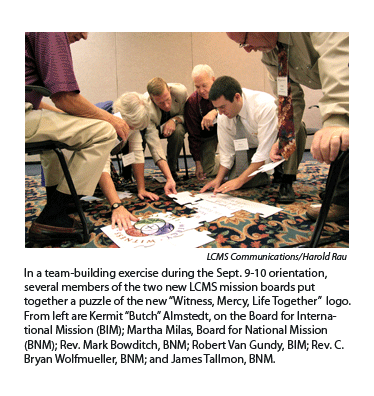By Joe Isenhower Jr. and Paula Schlueter Ross
The two new mission boards formed out of sweeping structure changes adopted by this summer’s Synod convention met for the first time during a Sept. 9-10 orientation in St. Louis for all those newly elected or appointed to service  in the national Synod.
in the national Synod.
About 80 people — board and commission members, other LCMS officers and Synod staff members — participated in the orientation held prior to the Sept. 11 installation service for Synod officers at Concordia Seminary, St. Louis.
A resolution adopted by 2010 convention delegates reduced the Synod’s seven program boards and some staffed commissions to the two new elected policy boards: the Board for National Mission and the Board for International Mission.
After the orientation and a joint follow-up meeting, each mission board met separately to elect officers to three-year terms.
The Board for National Mission elected:
- Rev. Steven C. Briel, senior pastor of St. John’s Evangelical Lutheran Church, Corcoran, Minn., chairman.
- Rev. Samuel Cosby, pastor of Mount Calvary Lutheran Church, Houston, vice-chairman.
- Rev. C. Bryan Wolfmueller, pastor of Hope Lutheran Church, Aurora, Colo., secretary.
Elected by the Board for International Mission were:
- Rev. Bernhard M. Seter, pastor of Zion English Lutheran Church, Grafton, N.D., and Trinity Lutheran Church, Drayton, N.D., chairman.
- John W. Edson, Plymouth, Minn., vice-chairman.
- Phillip A. Magness, Bolingbrook, Ill., secretary.
Reflecting on the orientation, Briel said he appreciated an activity in which board members were asked to list their “hopes and concerns” for their respective boards.
“This was a very helpful exercise since it caused many of us to take time to reflect on some of the challenges our Synod faces as we continue to spread the saving Gospel of our risen Lord Jesus while remaining faithful to God’s pure Word and our Lutheran Confession,” Briel told Reporter via e-mail. “While there is certainly some apprehension about how we will carry out our work under the new structure that was adopted by [the] convention this past summer (e.g., what are the parameters of our authority and our particular responsibilities), most of us are excited to accept this challenge and forge the way ahead, which we all hope will be more efficient, while at the same time protecting the rights of the congregations we serve and maintaining the solid, confessional voice for which the LCMS is known throughout the world.”
Seter said his hope was that any “lack of focus and clarity in [the Synod’s] mission and life together … could be alleviated, and the joy that we all felt over the response from the people in the pews over events like [Hurricane] Katrina and works of mercy in general could be continued.”
His hopes, he said, were “reinforced” by the “Witness, Mercy, Life Together” emphasis presented during the orientation “that graphically expresses in a simple yet profound way what it means to be a member of the body of Christ.”
Seter’s “concern” was whether or not there would be enough time “to get this right.”
Seter said both boards “are faced with something that no one has faced since the Synod was formed. We are in uncharted territory here, and we want to get it right.”
The two new boards also met together for worship, Bible study, to walk through new Bylaws for their boards, and other presentations to help them gain an understanding of the Synod and their own roles and responsibilities.
For one of those Bible studies, Synod First Vice-President Rev. Herbert C. Mueller Jr. concentrated on koinonia [life together] in the Gospel.”
During a “getting to know each other” exercise, members of the two mission boards formed small groups to put together a puzzle of the logo for “Witness, Mercy, Life Together — In Christ for the Church and World” — discovering that to complete the puzzle, they had to depend on and work with others outside their own groups.
Synod President Rev. Matthew C. Harrison and Dr. Albert C. Collver III, director of church relations for the Synod, introduced the new emphasis during the orientation.
Harrison referred to the emphasis as “profoundly biblical and theological. And it’s a theme that is so simple, yet at the same time we can invite our seminaries, the Commission on Theology and Church Relations, or Concordia University System and others [to] mine the depths of the Old Testament and New Testament witness on these fundamentals of the church’s life.”
Describing the emphasis as “a work in progress,” Collver told the 80 orientation participants, “We want to suggest [that] the work of our Synod can all be wrapped up into ‘Witness, Mercy and Life Together — In Christ, for the Church and the World.’ ”
He said that leading up the orientation, “we spent a lot of time talking about how we were going to restructure the Synod,” referring to the work of Harrison, himself and others, including Rev. Jon Vieker and Barb Below, senior assistant to the president and assistant to the president, respectively.
“The structure of the Synod is there in order to help the church accomplish its mission,” Collver said. “Where do we go from here?”
Article III of the Synod’s Constitution, which lists the church body’s objectives, can be concisely summed up “under the categories of ‘Witness, Mercy, Life Together,’ ” Collver suggested.
He cited numerous Scripture passages in reference to the new emphasis and invited those at the orientation to “give us feedback and also think about how we can expand this further.”
Collver also spoke of “how … these areas [of the emphasis] are interrelated to one another. I think this is an important aspect as we start to think toward how our Synod is going to function together and live together under a new restructuring.”
The logo for the new emphasis features its wording around three interlocking circles centered with a cross.
“Everything we do centers on the cross of Christ,” Collver said. “And everything that we do should be for the church. It should be for the individual, for the congregation, for the district, for the Synod, for the church at-large, and this includes our work with other churches around the world. Our church should be missional. It should be proclaiming the Gospel of Christ.”
In comments later to the Synod Board of Directors, Harrison said that the new emphasis “seems to be going over fairly well” with those to whom it is being introduced. “I feel that it’s nicely scalable for individuals, congregations, and all the entities that make up our Synod.”
For more about the “Witness, Mercy, Life Together” emphasis, go to www.lcms.org/emphasis.
Below, who served as facilitator for the orientation, described it in an e-mail to Reporter as “an opportunity to gather many individuals together from various boards and commissions. It was a mixture of individuals — some with lots of experience in boardsmanship and others who were just beginning the adventure of being involved in synodical leadership as a member of a board.”
She also referred to the two days as “an opportunity to share in depth the president’s emphasis on ‘Witness, Mercy, Life Together’ and help guide discussion of how all board members can think about their work along these emphases.”
“My overall feeling is that people enjoyed what we had prepared and were glad to be together,” she said, adding that many commented “they were honored to serve on a board and willing to help in any way that they could.
“The challenge is that all board members are wondering ‘how do the structure and governance changes impact the work my board will be doing?’ ” Below continued.
“Answers to these types of questions will become clearer as we all work within the new structure and with the new Bylaws,” she wrote. “The ‘Witness, Mercy, Life Together’ emphasis is helpful for everyone to see how the work of the boards overlap and are focused on Christ. … We will trust that God grants us all the much-needed wisdom to identify the best process in the new structure for the boards and commissions to work together to accomplish the work of the church.”
Below also shared that 60 percent of the orientation participants turned in written anonymous evaluations — all agreeing that “worship enhanced the board orientation meetings.” Other responses ranged from “words of encouragement” to “recognition of difficulties” and “constructive criticism,” she said.
For instance, one participant wrote, “Thank you for all of your work. I have a lot of hope for the future of Synod. We have great leaders!” And from a member of one of the two mission boards: “It is confusing because we are not sure what we are to do about this [referring to some crossover of programs between national and international offices] … and now we have to deal with these complexities.”
“I am very excited to begin work with these two new boards filled with a diverse mixture of extremely talented and gifted people from a variety of backgrounds and experiences,” Below said. “The board members are much like me right now — excited to serve and overwhelmed by the task at hand.”
Posted Sept. 22, 2010




